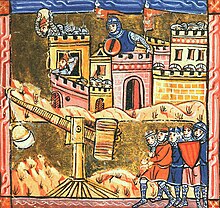| The Third Crusade | |||||||||
|---|---|---|---|---|---|---|---|---|---|
| Part of the Crusades | |||||||||
 Siege of Acre | |||||||||
| |||||||||
| Belligerents | |||||||||
|
Levantine
Crusader states: Eastern Christian allies: |
Sunni Muslim states:
Nizari Ismaili Muslims: Eastern Christian opponents: | ||||||||
| Commanders and leaders | |||||||||
|
Crusaders: Levantine Crusader states: Military orders: Eastern Christian allies: |
Sunni Muslim forces: Nizari Ismailis: Eastern Christian opponents: | ||||||||
| Strength | |||||||||
|
36,000–74,000 troops in total (estimate):
Two additional contingents also joined Frederick's army while travelling through byzantine empire. Numbered about 1000 men. |
Ayyubids: 40,000 (Saladin's field army, 1189 – estimate) [7] 5,000–20,000 (Acre's garrison, 1189) [8] [9] Seljuks: 22,000+ (Qutb al-Din's field army only, 1190) [10] [11] | ||||||||
Viking raids
- ^ a b Frank McLynn. "Richard and John: Kings at War." Page 219.
- ^ Tyerman, p. 436
- ^ Loud 2010, p. 19.
- ^ Hunyadi, Zsolt (2011), A keresztes háborúk világa, p. 41.
- ^ McLynn, p. 219: breakdown includes 2,000 Outremer levies, 1,000 Templars and Hospitallers, 2,000 Genoese and Pisans, and 2,000 Danes, Norwegians, and Turcopoles.
- ^ Hosler 2018, pp. 72–73.
- ^ Hosler 2018, p. 54.
- ^ Hosler 2018, p. 34.
- ^ Pryor, John H. (2015). "A Medieval Siege of Troy: The Fight to the Death at Acre, 1189–1191 or The Tears of Ṣalāḥ al-Dīn". In Halfond, Gregory I. (ed.). The Medieval Way of War: Studies in Medieval Military History in Honor of Bernard S. Bachrach. Farnham: Ashgate. Page 108.
- ^ Tyerman p. 422: "After desperate fighting involving the Emperor himself, the Turks outside the city were defeated [by the Imperial and Hungarian army], apparently against numerical odds."
- ^ Loud 2010, p. 104: the Seljuks lost 5,000+ men per their own bodycount estimates on May 7, 1190, soon before the Battle of Iconium.

